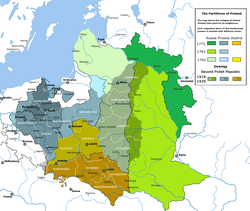Self-Defence of Lithuania and Belarus (1918)
Self-Defence of Lithuania and Belarus (Polish: Samoobrona Litwy i Białorusi) was a voluntary military formation created during the reconstitution of sovereign Poland towards the end of World War One in the Kresy macroregion. Self-Defence was composed mostly of the Poles from the nascent Second Polish Republic, after a century of Partitions.[1]
History

The areas of operation of the formation were centered around Wilno (now, Vilnius), Minsk (Mińsk) and Grodno. The unit, formed in 1918 was primarily involved in protecting local residents from the Russian Army deserters and other bandits. The Samoobrona quelled robbery by the peasants and repelled the incursions from the Bolshevik bands which were following the retreating German Ober-Ost forces.[1]
On 8 December 1918 General Władysław Wejtko formerly of the Imperial Russian Army (involved in the creation of Samoobrona), arrived in the Polish capital of Warsaw, where the Chief of State Józef Piłsudski confirmed his military rank of Lieutenant general in the newly-formed Polish Army and nominated him as the leader of all Polish voluntary forces in the area of present-day Lithuania and Belarus.[1] Wejtko received 375,000 Marks from the Kresy Defense Committee for the current needs of Samoobrona including provisions, allowances, the purchase of firearms, and horses.[2]
The militia was soon overwhelmed by the numerically superior Bolshevik armies. In December 1918, in Minsk, a group of roughly 1,500 Poles and Belarusians under the Samoobrona banner rose to arms to defend the city against the advancing forces of the Soviet Russia.[1] However, due to Russian numerical superiority, and the lack of ground support from the short-lived Belarusian National Republic, the division withdrew towards central Poland. Shortly thereafter, a roughly 2,500 men-strong Samoobrona force was created in Wilno (modern Vilnius) in early January 1919, to defend it against the Reds. In the effect of four-day-long battle for the city (which lasted until January 5, 1919), the Polish forces were pushed back near Nowa Wilejka (modern Naujoji Vilnia) on the outskirts of Wilno and retreated in the direction of the Regency Poland.[lower-alpha 1] The area changed hands several times over the next few months during the struggle of various opposing forces in the Vilna offensive of April 19–21, 1919, as well as in Operation Minsk of early August 1919.[1]
After January 8, 1919, most of the 'Samoobrona' forces were gradually restructured into a single military unit, the 1st Lithuanian-Belarusian Division, under the command of General Władysław Wejtko.[3] It became officially part of the newly formed Polish Army. The division took part in the Polish-Soviet War of 1919-1920.[1]
Footnotes
- ↑ Bezpośrednie starcie nastąpiło pod Nową Wilejką, gdzie ułani wileńscy w nocy z 2 na 3 stycznia 1919 roku zwarli się z czerwonymi. 2 500 ludzi broniło dostępu do Wilna jeszcze przez 3 dni, do 5 stycznia kiedy to centrum Wilna znalazło się pod ogniem Rosjan po zdobyciu przez nich wzgórza nazywanego wzgórzem Trzech Krzyży. Oddziałom samoobrony nie pozostało nic jak tylko udać się do Królestwa do nowo formowanej Dywizji Litewsko-Białoruskiej. — Krzysztof Janikula [1] [Part 1]
Citations
- 1 2 3 4 5 6 7 Krzysztof Janikula (August 25, 2008). "War of the 1920" [Wojna roku 1920 / cz. 1]. Part 1. Portal militarny Militaria.tm.pl. Archived from the original on August 28, 2008. Continued at: "War of the 1920" [Wojna roku 1920 / cz. 2]. Part 2. Sources: Bohdan Skaradziński, "Sąd Boży 1920 roku." Andrzej Albert, "Najnowsza Historia Polski 1914-1993". Archived from the original on 2009-10-12.
- ↑ "Self-defense in the Kresy (September 1918 – January 1919)" [Samoobrona Kresów (IX 1918 - I 1919)]. Kraków: Koło Kombatantów przy AGH (Combatants Club at the AGH University of Science and Technology). 2017.
- ↑ A. Łowczak, J.M. Sołdek (May 13, 2007). "General from Nałęczow - biography of Władysław Wejtko" [Nałęczowski generał]. Part 1. Gazetka. Szkoła im. Stefana Żeromskiego w Nałęczowie. (Part 2). Archived from the original on May 13, 2007 – via Internet Archive.
References
- "1. Samoobrona kresów (IX 1918 – I 1919)." Koło Kombatantów przy AGH. Kraków, 2017.
- "2. Początkowy etap wojny polsko-bolszewickiej (II - XII 1919)." Koło Kombatantów przy AGH. Kraków, 2017.
- Short entry from Encyklopedia Interia (in Polish)